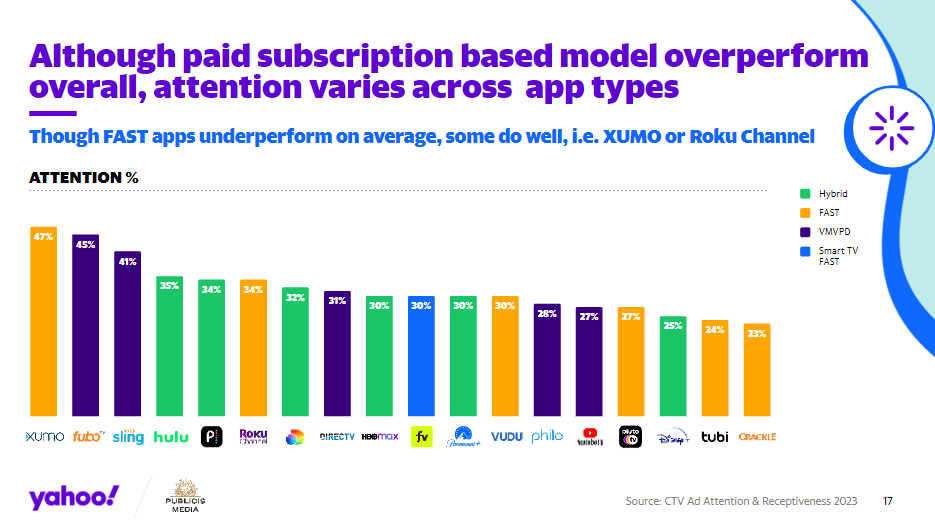
With more ad dollars flowing to ad-supported connected TV, a new study aimed to determine if streamers were paying attention to the commercials they are showing and found ways to improve how closely viewers look at advertising.
The study found that nearly every variable affected attention, from the streaming service type to the content viewed, the time of day, the viewer’s age and how frequently an ad is seen.
On a fundamental level, the study, commissioned by media agency Publicis Media and Yahoo found that most consumers were OK with seeing commercials during programming if it meant they’d pay less — or nothing — to watch. According to the study, 82% of CTV viewers expect ads on free streaming services and seven in 10 ad-supported VOD users are at least somewhat satisfied with their CTV experience.

But the data on viewability and attention, collected by TVision through facial recognition and eye tracking, and the information on receptiveness, resulting from surveys conducted by Open Mind Strategy, found that paying customers paid more attention, in some cases.
The study found that ad-supported tiers of subscription services — including Hulu, Peacock and HBO Max — and virtual multichannel video programming distributors (vMVPDs) like YouTube TV, Philo and FuboTV, generated higher attention than commercial-free versions. The attention percentage for vMVPDs was 35% and the attention percentage for ad-supported hybrids was 33%. That was higher than the 30% generated by smart-TV FAST channels (30%) or FAST platforms (28%).
Similarly, hybrids and vMVPDs drew more attention time than their free counterparts.
But the study found that some FAST apps were among the higher scorers in terms of attention. Xumo actually had the highest attention percentage of the apps studied, with 47%, and Roku was in the top 20 with 34%.
The Yahoo and Publicis Media study found that younger viewers (under 40) are almost 60% more likely to spend time with hybrid applications than their older counterparts.
Commercials that appeared on content with high engagement — crime dramas, political commentary, game shows — generated higher attention shares, compared to spots that aired in awards shows, sci-fi or action/adventure programming.
The highest-performing commercials featured people or elements from the show being watched.
Commercials needed six to 10 exposures to generate peak attention, but relatively few ads achieved that level of exposure. Meanwhile, being overly repetitive had a negative impact on brand sentiment. Changing the ad creative over multiple exposures had a positive impact on receptiveness, the study found.
And as on other TV platforms, pod position mattered, with the first commercial in a pod getting more attention time than spots in the middle or at the end of a pod.
The study analyzed 66,000 ads from January to November 2022. The TV panel included 5,000 households and 15,000 individuals who received 1.3 million impressions in four CTV environments. The Open Mind Strategy survey had 1,000 respondents. ■







